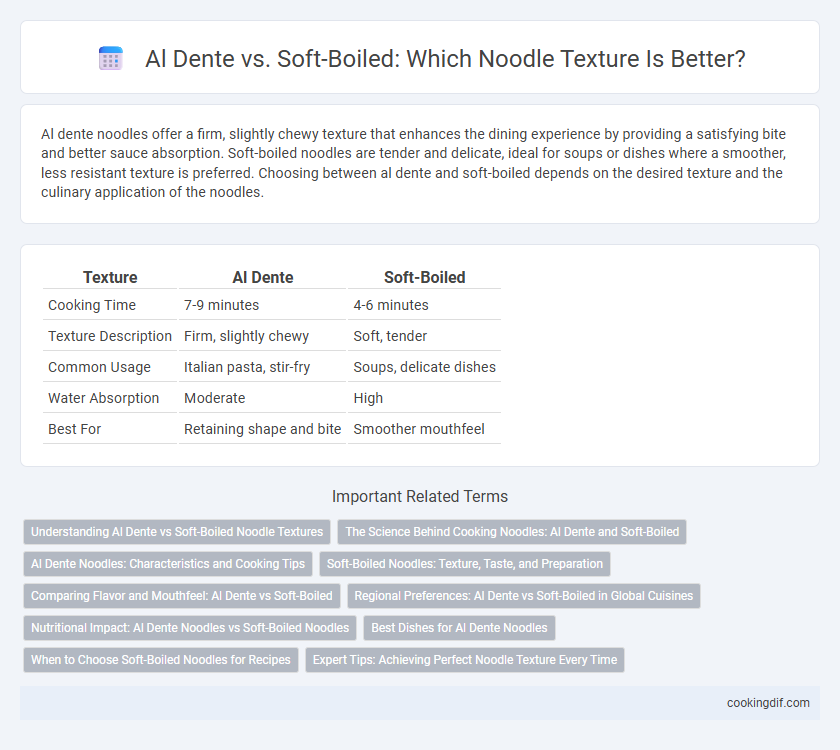Al dente noodles offer a firm, slightly chewy texture that enhances the dining experience by providing a satisfying bite and better sauce absorption. Soft-boiled noodles are tender and delicate, ideal for soups or dishes where a smoother, less resistant texture is preferred. Choosing between al dente and soft-boiled depends on the desired texture and the culinary application of the noodles.
Table of Comparison
| Texture | Al Dente | Soft-Boiled |
|---|---|---|
| Cooking Time | 7-9 minutes | 4-6 minutes |
| Texture Description | Firm, slightly chewy | Soft, tender |
| Common Usage | Italian pasta, stir-fry | Soups, delicate dishes |
| Water Absorption | Moderate | High |
| Best For | Retaining shape and bite | Smoother mouthfeel |
Understanding Al Dente vs Soft-Boiled Noodle Textures
Al dente noodles are cooked to retain a firm, slightly chewy texture that enhances the noodle's structural integrity and flavor absorption, making them ideal for pasta salads and Italian dishes. Soft-boiled noodles are cooked longer until tender and pliable, favored in soups and dishes requiring a more delicate, smooth mouthfeel. Understanding these textures allows chefs to optimize noodle cooking times to match specific culinary requirements and desired eating experiences.
The Science Behind Cooking Noodles: Al Dente and Soft-Boiled
Cooking noodles al dente preserves the firm, chewy texture by partially gelatinizing starches, preventing overhydration and breakdown of the noodle's structure. Soft-boiled noodles undergo complete starch gelatinization and absorb more water, resulting in a tender, softer bite. Understanding starch gelatinization and water absorption is crucial for achieving desired noodle texture based on cooking time and temperature.
Al Dente Noodles: Characteristics and Cooking Tips
Al dente noodles are distinguished by their firm texture and slight resistance when bitten, offering an ideal balance between chewiness and tenderness. Achieving this texture involves cooking noodles for 1-2 minutes less than the package instructions recommend, followed by immediate draining and rinsing with cold water to halt further cooking. Maintaining al dente noodles enhances sauce absorption and preserves the dish's structural integrity, making them preferred for pasta salads and Italian recipes.
Soft-Boiled Noodles: Texture, Taste, and Preparation
Soft-boiled noodles offer a tender and springy texture that absorbs flavors more deeply than al dente noodles, creating a rich and comforting mouthfeel. The preparation involves boiling the noodles slightly longer, resulting in a softer consistency ideal for brothy dishes or stir-fries where a delicate bite complements the sauce. This cooking method enhances the noodle's chewiness while maintaining enough firmness to prevent mushiness, balancing texture and taste perfectly.
Comparing Flavor and Mouthfeel: Al Dente vs Soft-Boiled
Al dente noodles offer a firm texture that enhances the bite and allows flavors to cling distinctly to the pasta surface, creating a more robust taste experience. Soft-boiled noodles yield a tender, smooth mouthfeel where the starch release results in a creamier texture, blending flavors more subtly throughout each bite. The choice between al dente and soft-boiled directly influences the overall dining experience, balancing chewiness with flavor absorption differently for each preparation style.
Regional Preferences: Al Dente vs Soft-Boiled in Global Cuisines
Regional preferences for noodle texture vary significantly, with Italian cuisine favoring al dente noodles prized for their firm, slightly resistant bite that enhances pasta dishes. In contrast, many Asian cuisines such as Japanese and Chinese often prefer soft-boiled noodles, emphasizing a tender, smooth texture that blends seamlessly with broths and sauces. These textural choices reflect cultural tastes and cooking techniques, influencing the overall dining experience across global culinary traditions.
Nutritional Impact: Al Dente Noodles vs Soft-Boiled Noodles
Al dente noodles retain a lower glycemic index compared to soft-boiled noodles, resulting in slower glucose absorption and improved blood sugar control. The firmer texture of al dente noodles preserves resistant starch, which supports gut health and enhances satiety. Soft-boiled noodles tend to break down more quickly during digestion, potentially causing faster spikes in blood sugar and reduced fiber efficacy.
Best Dishes for Al Dente Noodles
Al dente noodles, characterized by their firm and slightly chewy texture, are ideal for dishes like traditional Italian pasta, stir-fries, and cold noodle salads where maintaining structure enhances the overall bite. The firm texture of al dente noodles ensures they hold sauces better and provide a satisfying mouthfeel, perfect for robust flavors in spaghetti bolognese, pad thai, and sesame noodle dishes. Soft-boiled noodles, by contrast, work better in soups and broths where a tender, silky consistency complements the surrounding ingredients.
When to Choose Soft-Boiled Noodles for Recipes
Soft-boiled noodles are ideal for recipes requiring a tender, smooth texture that easily absorbs sauces and broths, such as in creamy or spicy noodle soups. Recipes like ramen or pho benefit from soft-boiled noodles, as they enhance the overall mouthfeel and balance the intense flavors. Choose soft-boiled noodles when the dish emphasizes broth richness and a comforting, melt-in-the-mouth noodle experience.
Expert Tips: Achieving Perfect Noodle Texture Every Time
Expert tips for achieving perfect noodle texture emphasize cooking noodles al dente for a firm, slightly chewy bite that enhances flavor absorption and prevents mushiness. Timing is crucial--boiling noodles for 1-2 minutes less than package instructions preserves their elasticity and nutritional value. Immediately rinsing noodles in cold water halts cooking, locks in texture, and prepares them perfectly for salads or stir-fries.
Al dente vs soft-boiled for noodle texture Infographic

 cookingdif.com
cookingdif.com